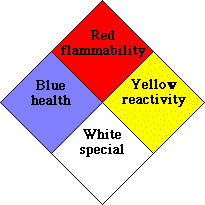Chemical Safety Guidelines
Law requires all chemical manufacturers to determine the physical, health and other hazards of all chemical products that they market. Manufacturers must communicate this information to all purchasers in the form of an SDS. The SDS communicates the potential hazards of a chemical. SDS are usually sent by the manufacturer with each chemical purchase. SDS can easily be found by an internet search containing the chemical name and "sds".
Copies of all SDS received from a manufacturer must be kept on file for 30 years. All persons engaged in University activities involving hazardous materials must have access to all applicable SDS. The SDS must be available for employees and students to review before beginning each chemical use activity. The MSDS must be the most recent version and easily accessible. Immediate access to hard copies of the SDS must be made available in each work area in case of emergency situations.
OSHA specifies the information to be included and the order it appears on all SDS. (29 CFR 1910.1200(g))
-
Sections
- Identification:
- This section identifies the chemical and its recommended uses.
- Hazard(s) Identification:
- This section identifies all hazards of the chemical and the appropriate warnings associated.
- Composition/Ingredients:
- This section identifies the ingredients including impurities and stabilizing additives. It also includes information on substances, mixtures, and all chemicals where a trade secret is claimed.
- First-Aid Measures:
- This section identifies the initial care that should be given by untrained responders to an individual who has been exposed to the chemical.
- Fire-Fighting Measures:
- This section identifies recommendations for fighting a fire caused by the chemical.
- Accidental Release Measures:
- This section identifies recommendations on the appropriate response to spills, leaks, and releases. It includes information to minimize exposure and whether the spill is a large or small spill and cleanup procedures.
- Handling and Storage:
- This section identifies safe handling practices and safe storage conditions.
- Exposure Controls/Personal Protection:
- This section identifies exposure limits, engineering controls and personal protective measures.
- Physical and Chemical Properties:
- This section identifies the physical and chemical properties of the chemical.
- Stability and Reactivity:
- This section identifies the reactivity hazards and the chemical stability information.
- Toxicological Information:
- This section identifies toxicological and health effects information.
- Ecological Information (non-mandatory):
- This section identifies the environmental impact of the chemical(s) if released to the environment.
- Disposal Considerations (non-mandatory):
- This section provides guidance on proper disposal and recycling practices.
- Transport Information (non-mandatory):
- This section provides guidance on classification information for shipping and transportation.
- Regulatory Information (non-mandatory):
- This section identifies the safety, health, and environmental regulations specific to the chemical.
- Other Information:
- This section identifies other information such as when the SDS was prepared or revised.
- Identification:
SDS are not required for biological/infectious agents or physical hazards encountered in the workplace. CSU-Pueblo Environmental Health & Safety will maintain copies of all SDS's. A copy of any individual SDS or questions can be obtained from Environmental Health Services or your Dean/Chair, Building Lab Coordinator. The chemical manufacturer or supplier will be contacted if additional information is required.
If you are working with chemicals or chemical products and would like to obtain a copy of the SDS for your product please call EHS at 549-2747 to request one. Below are links to various online databases of SDS. Hazard Communication training is available through the EHS Department, please call 2747 for more info.
NFPA Placards
It is required that each laboratory or work area where chemicals are used or stored be posted with the standard NFPA placard. The system is based on a color-coded warning with blue indicating health hazard, red indicating flammability, and yellow indicating reactivity. A numerical number is assigned to each color-coded area with a range from 0 to 4, the higher the number, the more hazardous the area. The highest number within each warning category for the chemicals present is posted on the placard.

4 = Severe Hazard
3 = Serious Hazard
2 = Moderate Hazard
1 = Slight Hazard
0 = Minimal Hazard


